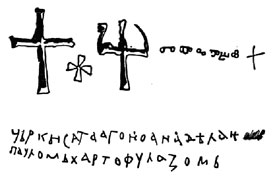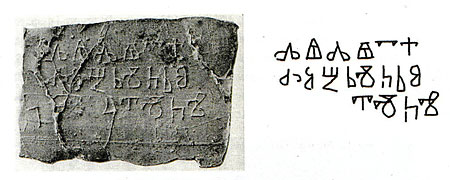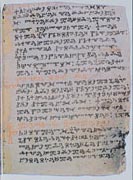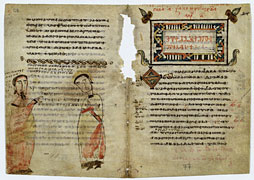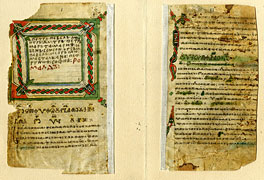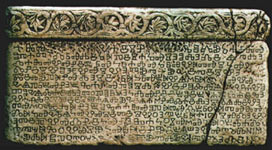In Celebration of the 1150th Anniversary of the Slavic Alphabet
Glagolitic Alphabet is the First Slavic Script
- Glagolitic Alphabet is the First Slavic Script
- Berčić Collection
- Croatia. Glagolitic Today
Svetlana Vyalova

The first Slavic alphabet was Glagolitic. It was created in 863 by Saint Cyril (Constantine) the Philosopher (827-14.II.869), likely, in conjunction with his brother - Archbishop Methodius, the Equal-to-the-Apostles, (820-6.IV.885), during their mission to spread Christianity in the Slavic language in Great Moravia. Moravia was a Slavic state in the Central Europe, where they arived at the invitation of Moravian Prince Rastislav. So, the Slavic script was devised to translate Christian writings into Slavonic. The brothers started the work in translating with the Gospels, Lectionary, Psalter, Apostle and some other liturgical texts. Cyril died in Rome and was buried there in the Basilica of St. Clement.
Unfortunately, noeither Glagolitic document nor book produced during the Great Moravian period of Sts Brothers (863-885) has been preserved, no written records from that time have suvived to the present day.
At the end of the year of 885, the Glagolitic alphabet was brought to Bulgaria by the disciples of Sts. Cyril and Methodius. Then these Slavic writing became widespread in Croatia.
The oldest combined Cyrillic and Glagolitic inscriptions dating about 893 were discovered in the former Bulgaria capital Preslavl on the walls and ceramic tiles of the church of the Tsar Simeon (893-927).
In Russia, the Glagolitic script was not popular. Neither East Slavic Glagolitic manuscripts nor birch bark documents written in Glagolitic have come down to us. The mixed Cyrillic and Glagolitic graffiti from the 11th century are found on the walls of St. Sophia's Cathedral in Novgorod and Kiev (3 are in Kiev, 20 - in Novgorod).
In Bulgaria, the Glagolitic script was replaced by Cyrillic alphabet almost everywhere at the beginning of the reign of Tsar Simeon (the traditionally accepted date is 893). It stayed longer in use in the west of the country - in Macedonia, where it was used even during the 12th century.
One of the oldest surviving manuscripts in Old Church Slavonic are the Kiev Glagolitic Missal (or Kiev Folios), dated at the latter half of the 10th century. (The Kiev Folios are now held in the Central Scientific Library of the National Academy of Sciences of Ukraine in Kiev).
The National Library can boast the earliest Glagolitic manuscripts dating the 11th century, among them are the celebrated Zograph Gospel and folios from the Euchologium Sinaiticum (Sinaitic Euchologion).
The strongest tradition of writing in Glagolitic were in Croatia, where the Glagolitic remained in active use for a long time (in Dalmatia, Croatian Littoral, Istria). Here the letters have acquired angular forms under the influence of the Latin Gothic script during the 12th century. This angular (or Croatian) Glagolitic script along with Latin and Cyrillic alphabet was used in Croatia until the 20th century.
Here you can compare the rounded Bulgarian-Macedonian Glagolitic writing (on the left) with the angular Croatian Glagolitic script (on the right):
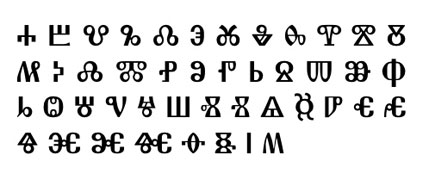

The comparison of round and square Glagolica is taken from the site http://kodeks.uni-bamberg.de/.
See also the Glagolitic Alphabet.
Glagolitic was widely used in epigraphy, mainly in Dalmatia, the Croatian Littoral and in the Croatian Adriatic Islands. Hundreds of inscriptions written on stones in the Glagolitic script, dated the 10th - 16th centuries, were found and described in this area.Only recently, the stone inscription dated at the latter half of the 10th century have been discovered in the south of the country near Dubrovnik.
Among the earliest monuments is the famous Baška tablet (c. 1100), found in the Church St. Lucy on the island of Krk. It contains a record of Croatian King Zvonimir's donation of a piece of land to this church.
The Glagolitic text from the Baška tablet is placed on the 100-kuna Croatia's banknote.

